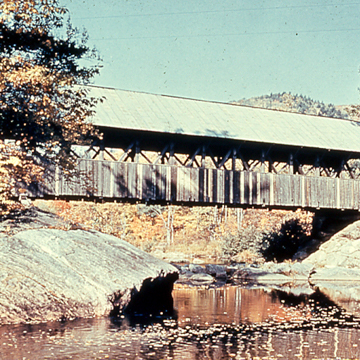You are here
Sunday River Covered Bridge
With many rivers and a robust lumbering industry, nineteenth-century Maine had at least 120 recorded wooden covered bridges. All were built on important arterial highways and were covered to protect wooden structural members from weather and rot. Only nine of them have survived; they are located in Littleton, Guilford, Kenduskeag, Bangor, Porter, Fryeburg Center, S. Andover, Wilsons Mills, and Newry. The latter, built over the Sunday River and designed in 1872 by Hiram York, survives as an excellent specimen.
Located in northwest Maine at Newry (incorporated in 1805), the first Sunday River Bridge was built in 1811. It was subject to frequent washouts, including a major one in 1869. When the bridge was rebuilt the following year, a windstorm destroyed it again eight months later. To replace it, the town voted on a covered truss bridge and selected York to build it. With careful attention to structural stability, York built the 100-foot-long bridge using the Paddleford Truss construction. The design was patented in the 1840s by Peter Paddleford of Littleton, New Hampshire, and features a series of cross braces between King posts; the bridge has stiffening panels at each end. The bridge’s top and bottom chords are built up of five vertical leaves of three-inch plank. York left no gaps between the planks, a special feature of the Sunday River Bridge. While the floor beams are not original, they are a close match. The floor planks are directly on the floor beams, with no stringers.
In addition to transportation, Maine’s covered bridges also served as places of assembly for meetings, voting, and observing the spectacle of the annual log drives. Most had granite block foundations, with shingled roofs and sides, and served principally pedestrians, carriages, and horse-drawn wagons. However, a few served rail lines. They were almost exclusively of truss design and, like the Sunday River span, highly vulnerable to the spring freshets that brought raging torrents, bearing logs, and other debris to batter the wooden structures. Such damage always resulted in political battles between the rival towns about how the cost of rebuilding would be apportioned. The great majority of Maine covered bridges spanned the Saco, Androscoggin, Kennebec, and Penobscot rivers, all of which were used in the nineteenth-century log drives and served towns with sizeable populations. Maine’s first substantial covered bridge (1797) spanned the Kennebec at Augusta. The bridges varied in length: the 792-feet length of the covered bridge over the Penobscot River between Bangor and Brewer is hardly matched by the Sunday River Covered Bridge span.
The Sunday River Bridge remained in service as a vehicular bridge until 1958. It was restored at the same time it was by-passed by a new bridge. The trusswork remains largely original. Known as the “Artists Bridge” for the frequency with which artists paint it, the bridge remains accessible to pedestrians and is owned and maintained by the Maine Department of Transportation.
References
Allen, Richard Sanders. Covered Bridges of the Northeast. Rev. ed. Mineola, NY: Dover Publications, 2004.
Briggs, John W., “Sunday River Bridge,” Oxford County, Maine. National Register of Historic Places Inventory–Nomination Form, 1969. National Park Service, U.S. Department of the Interior, Washington, DC.
Writing Credits
If SAH Archipedia has been useful to you, please consider supporting it.
SAH Archipedia tells the story of the United States through its buildings, landscapes, and cities. This freely available resource empowers the public with authoritative knowledge that deepens their understanding and appreciation of the built environment. But the Society of Architectural Historians, which created SAH Archipedia with University of Virginia Press, needs your support to maintain the high-caliber research, writing, photography, cartography, editing, design, and programming that make SAH Archipedia a trusted online resource available to all who value the history of place, heritage tourism, and learning.














